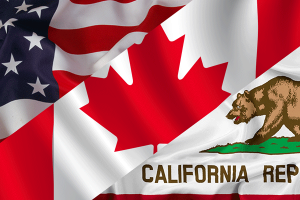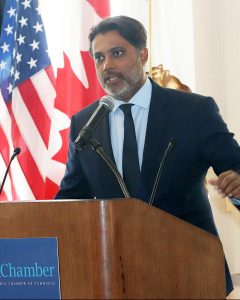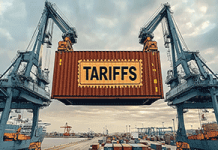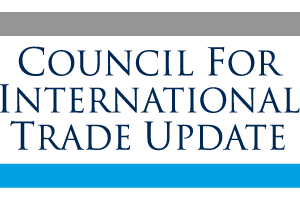 The Canada-U.S. trading relationship is at an inflection point, and how we meet this moment will affect North American economic security and competitiveness for decades to come.
The Canada-U.S. trading relationship is at an inflection point, and how we meet this moment will affect North American economic security and competitiveness for decades to come.

We face a significant threat to North American free trade, with potential U.S. tariffs that could harm the US$1 trillion Canada-U.S. economic partnership — a partnership that supports security and prosperity for millions. In the United States, 8 million jobs are linked to trade with Canada, including over 840,000 jobs with Canadian companies — 90,000 of which are in California.
Our North American industrial base is stronger and more resilient due to the flow of talent, investment, and innovation between Canada and the United States, and our deeply integrated supply chains across sectors like automobiles, construction and agriculture. By trading essential goods at competitive prices, Canada and the United States make life more affordable for millions of people in both countries. In California, Canada is not only your largest international customer for agriculture and agri-food products, including wine, but also one of your top sources of foreign direct investment.
But tariffs threaten this mutually beneficial partnership. While they’ll hit Canadian exporters hardest, the true cost will be felt far more widely, including by U.S. companies, workers and consumers. In a trade war, there are no winners.
Potential tariffs on Canadian exports could take effect as early as March 4, including 25% on goods and 10% on energy. Additional 25% tariffs on steel and aluminum may start March 12, potentially raising tariffs on Canadian steel to 50% or more. The Trump administration has also proposed 25% tariffs on automobiles, lumber, and forest products, set for April 2. Further global and reciprocal tariffs could be introduced soon, pushing tariffs even higher.
In every one of these scenarios, the prices Americans pay for food, gas, housing, vehicles and appliances will go up, with low-income families and small businesses facing the biggest strain from cost increases. Where will American industry and consumers see the biggest impacts?
- Higher costs for food and agricultural inputs: Over 70% of U.S. potash — a critical input boosting agricultural production — is sourced from Canada. A 25% tariff on Canadian potash could cost U.S. farmers $1.2 billion. If tariffs cause fertilizer to become more expensive, farmers may use less, crop yields will decrease, and food prices will go up.
- Housing: Over 80% of U.S. softwood lumber imports come from Canada. U.S. tariffs on Canadian lumber will make construction more expensive at a time that communities in California are urgently trying to build. A 25% tariff could raise the cost of new home builds by more than US$30,000.
- Energy: Over 60% of U.S. crude oil imports come from Canada, which supplies nearly a quarter of U.S. refinery intake. Tariffs on Canadian energy will be a tax on U.S. consumers, raising prices at the pump across the country. Industry analysts estimate that a 10% tariff on Canadian crude oil could raise gas prices by over 20 cents per gallon.
- Manufacturing: About 70% of Canadian exports to the United States are used in manufacturing, and Canada supplies nearly a quarter of U.S. steel imports. Tariffs on Canadian steel, aluminum, and critical minerals will raise production costs for key California industries like electronics, automotive, and aerospace, while also weakening U.S. supply chain resilience in defense, agriculture, and information technology (IT).
Canada is committed to strengthening our economic partnership with the United States and to working together to resolve shared concerns, including related to border security. Despite Canada being responsible for less than 0.2% of fentanyl and under 1% of illegal migration into the United States, we are investing over US$1 billion in new equipment, infrastructure, and technology; launching a Canada-U.S. Joint Strike Force to combat organized crime, illegal fentanyl, and money laundering; and appointing a new Fentanyl Czar.
However, despite these actions, there is no guarantee that tariffs will not be imposed. And if tariffs are placed on Canada, our government will respond and stand up for the deal that we struck with the United States, which provides for 99% tariff-free trade between our two countries.
This is a crucial moment for the Canada-U.S. partnership. Our trading relationship is the foundation of the strongest, safest, most prosperous partnership in the world. We cannot let trade barriers harm our workers, our industries, or the progress we’ve made. The true cost of tariffs goes beyond higher prices and job losses — it will erode the United States’ strategic advantage, making North America and the U.S. less competitive and secure.
We thank our friends at CalChamber for the opportunity to share this message, and we urge our trusted partners to continue mobilizing and communicating the value of this partnership. We are committed to working with you to preserve a secure and prosperous North America.
Rana Sarkar is Consul General of Canada in Northern California.

